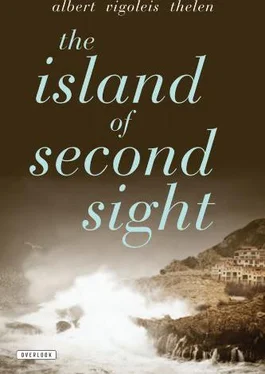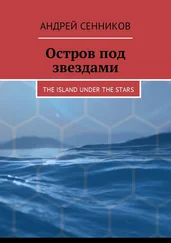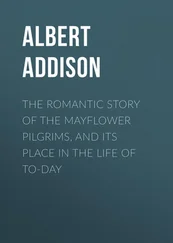A tourist disembarkation at the harbor in Palma takes the better part of an hour. Finally the masses have dispersed to the waiting automobiles. The tour director gives the high sign, and the first cars start out: Group 1, Guide 1, then five minutes later Group 2, Guide 2, and so forth, until the snake is winding its way across port city and island.
First stop: La Lonja, the ancient trade center, an eloquent witness to the former wealth of the city. “As you can see, ladies and gentlemen, this is a large Gothic sandstone building with small minarets, 1st half of the 15th century, built by Guillermo Sagrera, richly ornamented with sculpture, four octagonal corner towers, connected by an ornate parapet with turrets. Inside — just follow me, please, but be careful, chips of stone have been known to drop down — here inside, the vast interior is divided by two ranges of three spiral columns. Especially notable is the collection of paintings from the 15th, 16th, and 17th centuries. A spiral staircase — up there, you can see it from here — leads to the roof and from there to one of the corner towers, whence a fine view of the city, the harbor, and the bay is obtained. But we won’t be going up, much too dangerous. Not too long ago an elderly lady, handicapped, fell from the parapet down to the street. Too late to save her, unfortunately.”
Dead bodies always make a big hit. The remainder of the above text can be found in Baedeker’s Spain , 1929 edition, pp. 124-25. Some guides, Beatrice without a doubt, passed on this information ipsis verbis . But I didn’t, for the simple reason that this sort of stuff bores me to tears. As a Führer my chief aim was to enter that building a few paces ahead of my charges, and with my panoramic Führer’s vision determine in an instant what things were all about. Then I collected my group and explained everything according to the dictates of my fancy. After a few introductory remarks, this fancy of mine transported me without ado back to the golden age of Mediterranean piracy. Inside this palace, I then elaborated, the pirates used to divide up their spoils. Abducted women were raped on the spot; the unattractive ones were sold as slaves. Up there in the corners were four small rooms for making gunpowder. And then I would introduce my favorite general: “He took care of the whole mess! Barceló cleaned up the entire mare nostrum ! Those paintings over there were done in commemoration of that savage era. Take a look at them, but you won’t see much. Covered with age-old patina. All right, let’s move on!”
The next guide is already coming near, and so I have to shield my own people from questionable elucidations. So far, so good. They liked my story. And that’s enough for me. The little gang of tourists got what they paid for. But wait — a little old lady with her nose in her Baedeker comes up and tells me that the book has it all different — isn’t this the “Lonja”? Another lady, this one even older (I had winked at her during my brief lecture) asks abruptly which of the two ought to know better, our Führer , a local resident after all, or that foreigner Baedeker? Hadn’t I been in this profession for quite some time? “Not only that, Madam. I have also been commissioned by a publishing house to edit a new guide to Mallorca containing hitherto unpublished material, most of which I have myself unearthed. And I intend to publish my findings despite a certain sensitiveness on the part of the island natives in historical matters.”
“Daddy, did you hear that? Our guide is going to publish a brand new book all about historical sensitivity on Mallorca! He’s our Führer , so let’s buy it! OK, Dad?”
“We certainly shall, Agnes. These people are pioneers of German culture abroad, and they are contributing to our nation’s prestige in foreign climes. After our tour we’ll ask him to join us in a toast to the fatherland. I’m sure he’d like that. But now pay attention, Agnes. This is not just a pleasure trip. We’re here as part of your education. Travel is more educational than home and school combined.”
“Excuse me!” Somebody comes up to me, interrupting my victims’ discussion about culture and education. “That painting over there in the right-hand corner. Isn’t that late Van Dyck?”
“That one? No, it’s early Hodler. But I’m grateful to you for asking such an intelligent question. Up to now no one has been able to establish just how that work of art ever got here to Mallorca. The Cantonal Museum in Bern is still investigating. Professor Iselin — surely you’ve heard of him — has come down here himself. He and I are working on it together.”
“Many thanks, very interesting. I think I’ve read about that somewhere.”
“Don’t mention it.”
Without stepping on the Swiss art expert’s toes, I was unable to add a single thing more to this story about where the painting belonged. A very distinguished-looking gentleman from the group stepped forward and — I could see it in his eyes — was about to ask me a very tricky question. Before he came anywhere near, I was already sitting in the car, and we coursed through streets and alleys toward the Cathedral.
I did know a thing or two about this building. I remembered a few architectural details from our mournful starvation walks in its vicinity. But — who was slumbering within the many sarcophagi; how wide, how long, how high; how many columns, when it was built, why it was built, with whose money, with whose sweat, who designed it, when the deterioration had set in, when it would be restored, how many people could fit inside it — Please, ladies and gentlemen, for God’s sake (that’s probably why it’s standing here) don’t ask, because I simply don’t know and I’d have to concoct stories to come up with answers. I’d rather you pray to your Führer . Churches are meant to be prayed in, not studied. Most people forget that.
We have half an hour for the Cathedral. I ask my group first of all to let the colossal space take its effect, which they all do; they crane their necks like chickens being eyed by a hawk. “Simply colossal!” “You’re so right!” Then comes the first question: why are the columns that support the central nave angled slightly inward? Damn it all, I never noticed that. They really are bent inward. My brain comes up with the Leaning Tower of Pisa — can I use that here somehow? Call it a “partial inclination”? But first I throw in the jazz that never fails to do its stuff: “That’s an excellent question, one that shows unusual powers of observation. Are you perhaps an art historian, and a very original one at that?” The young man nods assent. I’ll have to be careful. Even on well-trodden paths there can be traps. Dad and Mom take one step forward and eye their son proudly for asking such a smart question. This evening the whole ship will know it: that young fellow will go far — he knows how to get at problems, and how to embarrass a tour guide. But wait just a minute. I make reference to one of the Pre-Socratics, who once said that the right question is half of its own answer. Still, I go on, in art history this maxim didn’t always hold, and most surely not in this particular cathedral. At this, the student’s parents’ eyes glaze over. The student himself says, “I beg your pardon?” and I can tell that with my remark I have threatened his pride as well as my own. But I continue: we could take two basic ideas as our point of departure: a religious idea and an architectural idea. To me it would seem more appropriate to combine the two, for as we know, the great cathedrals of the world were conceived as amalgams of religious-rhythmic contemplation and secular-technical visual acumen. For this very reason, our own centuries have no longer produced cathedrals. People in my group nod their heads. And they nod even more energetically once I start using motions of the hands to illustrate my assertions. Especially effective in this setting is what might be termed the “pumpkin outline,” employed as an indication of the cathedral’s limitless dimensions. It never fails.
Читать дальше












